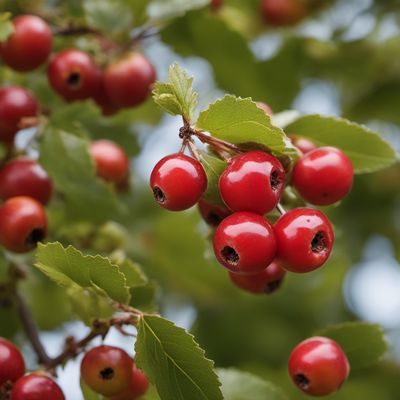
Ingredient
Silverberries
The Shimmering Gems of the Culinary World
Silverberries are small, round fruits that measure about 1 cm in diameter. They have a translucent, golden-yellow skin with tiny silver speckles, giving them a shimmering appearance. The flesh is juicy and slightly tart, similar to cranberries, with a hint of sweetness. The texture is soft and delicate, with small edible seeds scattered throughout. When bitten into, silverberries release a burst of refreshing juice, leaving a pleasant aftertaste.
Origins and history
Silverberries are native to North America and have a rich history among indigenous communities. They were traditionally used for medicinal purposes due to their high vitamin C content. The fruit was also valued for its ability to thrive in harsh climates and poor soil conditions, making it an important food source for early settlers and explorers.
Nutritional information
Silverberries are a nutritional powerhouse, packed with vitamins A and C, antioxidants, and dietary fiber. They are low in calories, with approximately 40 calories per 100 grams.
Allergens
There are no known allergens associated with silverberries.
How to select
When selecting silverberries, look for fruits that are plump, firm, and evenly colored. Avoid any that appear shriveled or have blemishes. The silver speckles on the skin should be intact, indicating freshness.
Storage recommendations
To maintain the freshness of silverberries, store them in the refrigerator in a breathable container or a perforated plastic bag. They can last for up to a week when properly stored.
How to produce
Silverberries can be grown by planting the seeds or by propagating from cuttings. They thrive in well-drained soil and prefer full sun exposure. However, they are also adaptable and can tolerate a range of soil conditions.
Preparation tips
Silverberries can be enjoyed fresh as a snack or used in various culinary applications. They can be added to salads, desserts, jams, or sauces. Their tartness pairs well with sweet dishes, and they can also be used to balance the flavors in savory recipes. To enhance their natural sweetness, lightly sprinkle silverberries with a touch of sugar before using them in recipes.
Substitutions
If silverberries are not available, cranberries can be used as a suitable substitute due to their similar tartness and texture.
Culinary uses
Silverberries are commonly used in jams, jellies, and sauces, adding a unique flavor and visual appeal. They can also be incorporated into baked goods, such as pies, tarts, and muffins. Additionally, silverberries can be used to infuse beverages, such as cocktails or flavored water, with their refreshing taste.
Availability
Silverberries are commonly found in North America, particularly in regions with colder climates, such as Canada and parts of the United States.
More ingredients from this category » Browse all

Buffalo berries
The Tangy Delight of Buffalo Berries

Elderberries
The Power of Elderberries

Riberries
The Vibrant Delight

Bayberries
The Hidden Gems of the Forest

Phalsa fruits
The Exotic Jewel of Summer: Phalsa Fruits

Dwarf elderberries
The Tiny Powerhouse: Exploring the World of Dwarf Elderberries

Midland hawberries
The Hidden Gems of Midland: Exploring the Delights of Hawberries

Hawberries
The Vibrant Delight: Exploring the World of Hawberries

Sorb fruits
The Sweet and Tangy Delights of Sorb Fruits

Red elderberries
The Vibrant Gems of the Forest

Guelder rose berries
Guelder Rose Berries: Nature's Vibrant Gems

Che berries
The Exotic Delight: Che Berries
